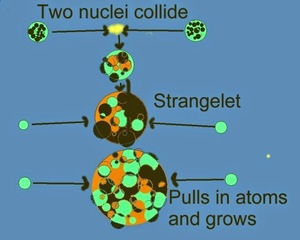International critic group 'Heavy Ion Alert' claim CERN Documents contradict claims of Safety Report for the Large Hadron Collider concerning Strangelet Risk
A strangelet, possibly produced at heavy ion collisions at the LHC at CERN, is a small fragment of strange matter that could in certain circumstances cause a chain reaction converting ordinary matter into strange matter.
The growth of the strangelet could theoretically continue until the whole planet would be absorbed into it. Once the size becomes macroscopic, such a dense object is usually called a quark star or "strange star".
This week, beneath the border of France and Switzerland, heavy ion collisions begin at near design energy in the Large Hadron Collider (LHC). An international campaign group Heavy Ion Alert concerned about the safety review process of CERNs Large Hadron Collider and with the production at LHC of dangerous 'strangelets', reveals in a report that most of the arguments concerning 'strangelet' attributes and production which are used for re-assurance in the CERN Council appointed 'LHC Safety Assessment Group' (LSAG) report are contradicted by CERNs own documents. Heavy Ion Alert's report, How CERNs Documents Contradict its Safety Assurances: Plans for ’Strangelet Detection at the LHC', argues that the lack of any independence from CERN in the safety review process has led to these neglects and that relevant information must have been knowingly withheld from the LSAG safety assessment.
CERNs LSAG report was undertaken and, after review by CERN's Scientific Policy Committee (SPC), approved in June 2008. Here, Heavy Ion Alert's report argues that the available evidence indicates a total lack of independence from CERN in the safety review process appointed by the CERN Council. Heavy Ion Alert's report goes on to refer to documents and articles showing that, for heavy ion collisions, most of the foundations for CERN's LSAG report safety assurances are in contradiction to various existing arguments given by CERN affiliated physicists involved with the LHC.
The Heavy Ion Alert report explains that according to a review published in 2000 by Nobel laureate physicist Prof Frank Wilczek and others, strangelets that can be considered dangerous would need to have certain attributes. While the LSAG report authors rejected the credibility of these attributes occurring, Heavy Ion Alert's listed documents show that CERN physicists working on the LHC consider these attributes could be realised.
One example Heavy Ion Alert identifies is how the LSAG report states that there is no need for concern about strangelets because of the:
'. . . impossibility to produce strangelets at the LHC . . .'
(LSAG Report, p.13)
while experimental researcher with CERN, Panos Katsas, states:
'my main area of interest is the study of exotic events in heavy ion collisions, especially the identification of strangelets, which are likely to be produced'
(The University of Athens . . . in CMS, CMS Times, 3 Dec 2007).
Katsas' statement relates to the incorporation of a detector subsystem, within the LHC, called CASTOR, designed primarily for the detection of strangelets. Other CASTOR documents predict that strangelets can be produced at the LHC at a rate of over one for every thousand heavy ion collisions (see link before end of press release). Other evidence that potential strangelet production is accepted is shown by a plan for detection of strangelets also at the ALICE detector at the LHC. Though no acknowledgement of these plans is given in CERNs safety report, indications of implied prior knowledge of them from at least two members of the LHC Safety Assessment Group (LSAG) is shown in Section 1 of the report below.
The available Heavy Ion Alert report presents further details on these issues and includes, in Section 4, a comparison of quotes between the above-mentioned sources and those of the LSAG report. Heavy Ion Alert here asserts that six official safety arguments are clearly contradicted.
According to Heavy Ion Alert coordinator Eric Penrose, author of the report: ’The result of the lack of independence in the official LHC safety review is that it fails to take account of even the stated opinions of CERN's researchers for the LHC concerning such vital questions as the feasibility of strangelet attributes and its production prospects. This shows a very serious deficiency in regulation for unprecedented experiments. This situation can only be addressed by the commissioning of a genuinely independent and interdisciplinary panel of experts which, along with a remit to consider LHC safety critical submissions from the public, would critically review the existing safety arguments for LHC operation.
See Heavy Ion Alert's report outlining the contradictions between LSAG report re-assurances and the statements of CERN researchers
Notes
1. Highest energy collisions yet between heavy ions by experiment, starting this week:
2. 'Strangelet':
3. CERN affiliations of the members of the two safety review teams (2008) for LHC:
4. Review by Wilczek et al. 2000:
R.L. Jaffe, W. Busza, F. Wilczek and J. Sandweiss, Review of speculative ’disaster scenarios at RHIC, Rev. Mod. Phys. 72 (4) (2000) 1125-1140, preprint:
5. LSAG report:
John Ellis et al 2008 J. Phys. G: Nucl. Part. Phys. 35 115004 preprint:
6. Katsas quoted in CMS Times, 3 Dec, 2007:
7. CERN published image of the CASTOR detector being installed at the LHC:
8. Evidence that the CASTOR detector is primarily for the detection of strangelets:
9. ALICE: Technical proposal for a large ion collider experiment at the CERN LHC, Chapter 11, Sect. 10, 1995
10. Further comments concerning need of independent review for LHC:
M. Leggett, Review of the risk assessment process used for the 2008 LHC safety study, 2009, 14pp. pdf,
and Eric E. Johnson, 'The Black Hole Case: The Injunction Against the End of the World', Tennessee Law Review, Vol. 76, No. 4, pp. 819-908, 2009; preprint:
www.heavyionalert.org
Artikel Online geschaltet von: / Doris Holler /
